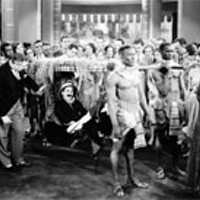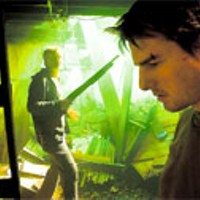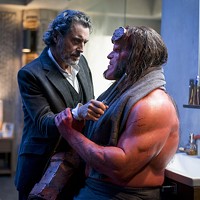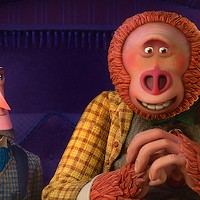

Fahrenheit 9/11 has emerged as a cinematic first: the blockbuster documentary. Yet it was Moore's previous piece, the Oscar-winning Bowling for Columbine, that made American audiences first realize that nonfiction films could be -- gasp! -- entertaining. Certainly, IMAX features like Everest and concert films dating back to Richard Pryor or the Rolling Stones have always enjoyed a modest degree of popular acceptance, but the more traditional documentary format has always been regarded as the ugly stepchild of American cinema, marginalized and ignored by the masses. But thanks to Columbine, the nonfiction genre has enjoyed success as never before: A glance at the all-time top moneymakers in this field (see accompanying chart) reveals that practically all of the titles were released within the last couple of years.
Of course, these grosses rank as a mere pittance when compared to the cash generated by Hollywood's fictional films -- even a colossal flop like the recent Around the World In 80 Days earned more than all documentaries except for Fahrenheit (on the plus side, nonfiction films cost peanuts to make, so their profit margins are often much more enviable).
At any rate, moviegoers who have acquired a newfound interest in documentaries won't be starved for selections. Here, then, are some rental suggestions of worthy nonfiction features produced within the last dozen years.
THE WAR ROOM (1993). "Every time a Democrat comes along who has some ideas, the Republicans ambush him. That is standard procedure." That savvy statement, spoken before the 1992 presidential election that found Bill Clinton thumping George Bush pere, was made by James Carville, the Clinton campaign manager and star of this Oscar-nominated documentary that illustrates in often amusing detail how the team managed to overcome petty hostilities and seize the day -- and the White House. The movie offers ample pleasures: A rare chance to see an animated Al Gore; Carville's popping blood vessels as he rails about how the mainstream press gave papa Bush a free ride on Iran-Contra but hammered Clinton about Gennifer Flowers; the cool-under-fire George Stephanopolous talking a Perot supporter out of reporting that Clinton fathered an illegitimate black child; the sharp comments by Bush staffer Mary Matalin, so much Carville's equal that it's easy to see why they became a couple; and Carville's exasperation when told (on election night, no less) by a waiter that the special on draft is Busch beer.
CRUMB (1995). Can art literally save a life? That's the question posed -- and answered -- in Terry Zwigoff's fascinating documentary about Robert Crumb, the notorious cartoonist who gave the world such counterculture touchstones as Fritz the Cat and the "Keep On Truckin'" images. More than just a character study, the film contrasts the peculiar artist with his two dysfunctional brothers and shows with amazing clarity how the channeling of Robert's talents into a productive career has perennially kept madness on the outside looking in. Keeping with the complex nature of its subject, the picture careens wildly between moments of great humor and instances of sobering tragedy -- for example, watching how the homemade comic books of Robert's brother Charles (who committed suicide circa the film's release) eventually gave way to pages of nothing but scribbles straight out of The Shining marks both the height of absurdity and the descent into insanity.
THEREMIN: AN ELECTRONIC ODYSSEY (1995). You may not know the name, but you know the sound. The theremin is the funky musical instrument that created the otherworldly reverberations employed in various science fiction flicks (including The Day the Earth Stood Still) and in the Beach Boys' "Good Vibrations." And Theremin: An Electronic Odyssey is the true story of Professor Leon Theremin, the man who invented this revolutionary device in the 1920s. Here's a life to file in the "truth is stranger than fiction" basket: A Russian immigrant who was living in New York at the time of his invention, Theremin was eventually kidnapped by Soviet agents and tossed into a Siberian labor camp. Long believed by the Western world to be dead, he was finally discovered concocting espionage gadgets for Joseph Stalin, but it would remain decades before he managed -- at the age of 95 -- to return to the US for a visit. Visually, Theremin is rather static, relying heavily on vintage snapshots and "talking heads" to relate its story. Yet the material itself is so patently bizarre that viewers will be quickly captivated by its myriad twists and turns.
UNZIPPED (1995). If nothing else, this movie about fashion designer Isaac Mizrahi served as an antidote to Robert Altman's Ready to Wear (Pret-a-Porter), an artificial look at the industry that was released around the same time. The creative process at work is one of the hardest things to capture on film, yet director Douglas Keeve does a fine job of taking us inside the mind of one of the shining stars in the couture culture. Mizrahi is revealed as a charismatic and sharp-witted artist whose love for his craft is clearly evident, and it's intriguing to watch how, over the course of the film, his demeanor slowly changes from carefree to testy as the date of his next show (the Fall "94 Collection) draws closer. The movie features appearances by supermodels Cindy Crawford (discussing her pores, no less), Linda Evangelista and Kate Moss, yet it's Mizrahi himself who remains firmly positioned on our mental runway.
THE BIG ONE (1998). The "forgotten" film on Michael Moore's resume, this follows the intrepid moviemaker as he travels across the country promoting his best-selling book Downsize This! Random Threats from an Unarmed American. By showcasing his guerilla tactics on the road while also interspersing footage from some of his speaking engagements, the movie becomes a hilarious (if not exactly fluid) hodgepodge of inspired sequences: Moore telling a Raleigh audience that he's determined to "put Jesse Helms behind bars"; Moore showing the checks he had mailed to various politicians to see if they'd cash them (labeled "Abortionists for Buchanan" and "Pedophiles for Perot" -- and, yes, they did cash them); and, finally, an unbelievable meeting with Nike CEO Phil Knight in which the mogul states that the reason his company employs impoverished teenage girls in Indonesia is because "Americans don't like making shoes" (after Moore offers evidence to the contrary, Knight adds, "Unemployed people will say anything to get work"). And Moore doesn't stop there: TWA, Steve Forbes and Borders Books & Music are some of the other targets whose reputations get downsized by his exposure of their corporate heartlessness.
MR. DEATH: THE RISE AND FALL OF FRED A. LEUCHTER, JR. (1999). Errol Morris finally won his Oscar this year for The Fog of War, but he's been making worthy nonfiction films for about two decades. Here, he comes up with a Holocaust piece unlike any I've ever seen -- one that focuses on a pitiful man who's unable to comprehend the magnitude of one of the most atrocious events in history. In 1988, Canadian neo-Nazi Ernst Zundel, on trial for attempting to incite racial violence with his books Did Six Million Really Die? and The Hitler We Loved and Why, asked Leuchter, a squirrelly inventor known for his "humane" devices of execution, to travel to Auschwitz, illegally take samples from the prison walls, and determine if the facilities were indeed used as gas chambers. After concluding that no Jews were gassed at the camp, Leuchter became a popular speaker on the Holocaust-denial circuit but, not surprisingly, found every other aspect of his life destroyed. Morris leaves it up to the viewer to determine whether Leuchter is a heinous anti-Semite or merely a clueless goober -- as a friend opined, this movie isn't about the banality of evil as much as the banality of idiocy. Either way, it's chilling to watch Leuchter casually chip away at the Auschwitz walls, never once letting the horrors of the war seep into his stone-cold soul.
JANE GOODALL'S WILD CHIMPANZEES (2002). Although originally shot for large-format theaters, this worthy tribute to a great humanitarian loses none of its appeal on DVD. Shot primarily in Gombe Stream National Park in Tanzania, the film opens with 40-year-old footage of the young Jane Goodall and her first experiences with chimpanzees. From there, it brings us to the present, with the still active, still beautiful Goodall (68 at the time of filming) introducing us to her swinging friends, all of whom have names because Goodall initially didn't realize that the scientific community preferred to number its study subjects. We learn that humans and chimps share about 98 percent of the same DNA; we watch as the kinder chimps snuggle with Goodall while the more rambunctious ones throw rocks at her; and we nod approvingly at this remarkable woman's complete adoration of her animal pals, displayed not only through her up-close-and-personal interactions but also through her extensive touring around the world, speaking passionately about the need for wildlife preservation.
TUPAC: RESURRECTION (2003). After just a few minutes into the film, it's clear to even those with no interest in astrology that Tupac Shakur was a Gemini, a fact that the late rapper himself confirms in interview footage shown midway through this incisive documentary. On one hand, here was a kid who took dance during his school years, who listed Don McLean, Lorraine Hansbury and William Shakespeare as influences, and who displayed enormous sensitivity in the film Poetic Justice. Yet here was also a social misfit who often submerged his finer qualities to foster a harsher persona, who exhibited streaks of misogyny on more than one occasion, and who lived a violent lifestyle even as he spoke about achieving goals through peaceful means. Clearly, Tupac never quite fit the stereotypical image of the gangbanging thug, and the strength of this documentary -- packed with interviews, home movie footage, and entries from Tupac's journals -- is that it never flinches in showing us why he made the choices he felt he had to make, even though they ended up costing him his life. For another provocative documentary on the man, rent Biggie & Tupac, which centers exclusively on the blood feuds between the East Coast and West Coast rappers.





